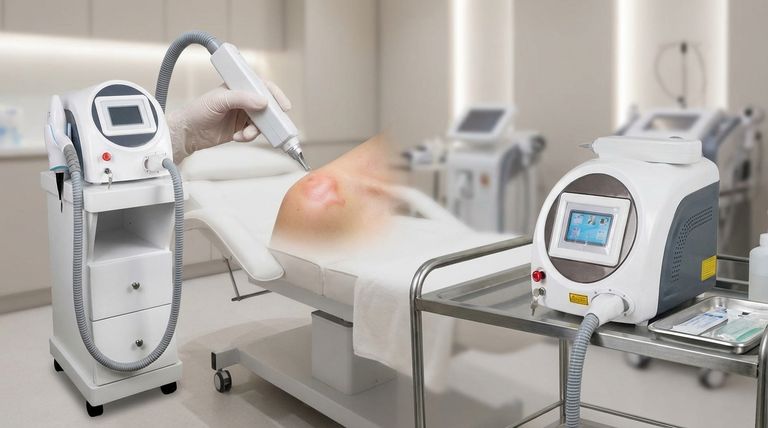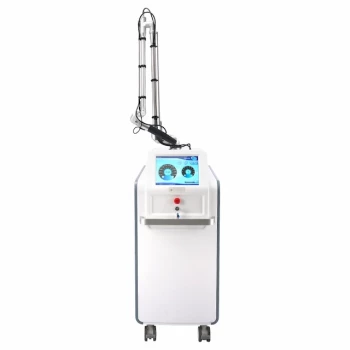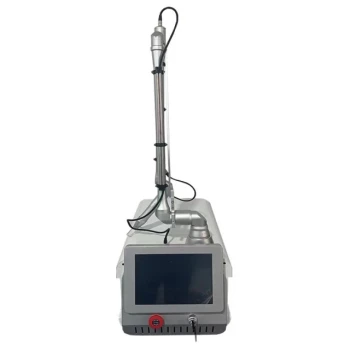The side effects of a Q-switch laser are typically temporary and a predictable part of the skin's healing process. Most patients can expect to experience immediate redness, mild swelling, and temporary pigmentary changes at the treatment site. While more serious complications are possible, they are uncommon, particularly when the procedure is performed by a qualified professional.
While most Q-switch laser side effects are a normal and transient part of the skin's healing response, the risk of significant complications is greatly minimized by choosing an expert provider and diligently following all post-treatment care instructions.

Immediate and Common Side Effects: The Body's Healing Response
The most common side effects appear almost immediately after treatment and are signs that the laser has effectively targeted the pigment and initiated a healing cascade.
Redness and Swelling
The intense energy from the laser creates a controlled thermal injury in the skin to shatter the targeted pigment. Your body responds to this with a natural inflammatory process, causing temporary redness (erythema) and mild swelling (edema), similar to a sunburn. These effects typically subside within a few hours to a couple of days.
Changes in Skin Texture
It is normal for the treated area to feel slightly tender or develop scabs or crusting, especially in tattoo removal or the treatment of pigmented lesions. This is a crucial part of the healing process as the body works to eliminate the shattered pigment particles.
Understanding Temporary Pigment Changes
Because Q-switch lasers work by targeting melanin and ink, temporary disturbances to the skin's natural pigment are a known side effect. These changes are almost always temporary.
Hyperpigmentation (Darkening)
Post-Inflammatory Hyperpigmentation (PIH) can cause the treated skin to become darker than the surrounding area. This occurs when the skin's healing response triggers an overproduction of melanin. It is more common in individuals with darker skin tones and usually resolves on its own over several months.
Hypopigmentation (Lightening)
Conversely, the laser energy can temporarily stun the cells that produce melanin (melanocytes), leading to a lightening of the skin known as hypopigmentation. This effect is also typically temporary, though it can sometimes take longer to resolve than hyperpigmentation as the cells slowly recover their normal function.
Understanding the Trade-offs: Rare but Serious Risks
Serious complications are not a normal part of the process and are often linked to provider experience, incorrect laser settings, or poor aftercare.
Risk of Infection
The laser creates a microscopic wound in the skin, temporarily compromising its protective barrier. If the area is not kept clean, or if scabs are picked prematurely, bacteria can enter and cause an infection. Following your provider's wound care instructions is critical to prevent this.
Risk of Scarring
Scarring is the most significant but rarest adverse effect. It can result from an overly aggressive treatment where too much energy damages the surrounding tissue, or as a secondary result of poor healing from an infection. This risk highlights the absolute importance of selecting a highly trained and experienced practitioner.
How to Minimize Risks and Ensure the Best Outcome
Your actions are as crucial as the treatment itself for achieving a safe and effective result. A successful outcome is a partnership between you and your provider.
- If your primary focus is safety: Choose a board-certified dermatologist or plastic surgeon with extensive experience in laser physics and treating your specific skin type and concern.
- If you are preparing for treatment: Meticulously follow all pre-treatment advice, which often includes avoiding sun exposure, tanning beds, and certain topical skin products.
- If you are recovering from treatment: Commit to the aftercare regimen provided, especially regarding sun avoidance, gentle cleansing, and allowing any scabs to heal naturally.
Understanding these potential effects empowers you to make an informed decision and partner effectively with your provider for a safe treatment journey.
Summary Table:
| Side Effect Type | Commonality | Duration | Key Characteristics |
|---|---|---|---|
| Common & Temporary | Very Common | Hours to Days | Redness, swelling, mild tenderness; part of normal healing. |
| Temporary Pigment Changes | Common | Weeks to Months | Hyperpigmentation (darkening) or hypopigmentation (lightening). |
| Rare & Serious | Uncommon | Can be Permanent | Scarring or infection; risk is minimized by an expert provider. |
Invest in Safety and Superior Results with BELIS
Choosing the right equipment is just as critical as choosing the right provider for minimizing side effects and achieving optimal outcomes. BELIS specializes in manufacturing professional, medical-grade Q-switch lasers that offer precise control and enhanced safety features, empowering clinics to deliver effective treatments with confidence.
Our advanced laser technology helps you:
- Minimize Patient Risk: Precise energy delivery targets pigment effectively while helping to protect surrounding tissue.
- Enhance Treatment Efficacy: Achieve clearer results for tattoo removal and pigmented lesion treatment.
- Build Patient Trust: Offer safe, predictable treatments that uphold your clinic's reputation for excellence.
Ideal for medical aesthetics clinics and premium beauty salons seeking to elevate their service offerings with reliable, high-performance technology.
Ready to enhance your laser treatments? Let our experts guide you to the perfect solution for your practice.
Contact BELIS today for a professional consultation
Visual Guide

Related Products
- Q Switch Nd Yag Laser Machine Tattoo Removal Nd Yag Machine
- Clinic Use IPL and SHR Hair Removal Machine with Nd Yag Laser Tattoo Removal
- Pico Picosecond Laser Machine for Tattoo Removal Picosure Pico Laser
- Pico Laser Tattoo Removal Machine Picosure Picosecond Laser Machine
- Diode Laser SHR Trilaser Hair Removal Machine for Clinic Use
People Also Ask
- Is Q-Switch laser safe for skin? Achieve Precise, Non-Invasive Skin Rejuvenation Safely
- Is Q Switched Nd:YAG laser good? The Gold Standard for Tattoo & Pigment Removal
- What are Q-switched lasers commonly used for? Remove Tattoos & Pigment with Precision
- What are the disadvantages of Q switching? Trade-offs in Pulse Control, Cost, and Beam Quality
- How long does it take to recover from Nd:YAG laser treatment? A Timeline for Every Procedure



















